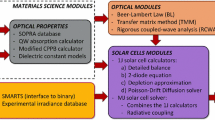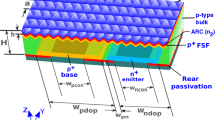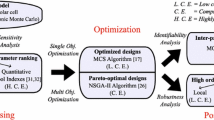Abstract
This paper reports on simulation techniques developed for the modelling and optimisation of complete, 2 × 2 cm2, high-efficiency silicon solar cells. We use three-dimensional (3d) device simulation to extract a J-V curve of an interior section of a cell. 2D simulations of the cell perimeter are then used to correct the J-V curves for the loss of carriers across the cell boundary. The resulting characteristics are input to a circuit simulation which connects the various cell sections into a model of a full cell. The J-V curve which results from that simulation can be directly compared to measured data. We find excellent agreement between simulation and measurement.
Access this chapter
Tax calculation will be finalised at checkout
Purchases are for personal use only
Preview
Unable to display preview. Download preview PDF.
Similar content being viewed by others
References
J. Zhao, A. Wang, P. P. Altermatt, S. R. Wenham, and M. A. Green. 24% Efficient silicon solar cells. In 1st World Conf. Photovoltaic Energy Conversion, Waikoloa, Hawaii, USA, December 1994. IEEE. To be published.
A. G. Aberle, P. P. Altermatt, G. Heiser, S. J. Robinson, A. Wang, J. Zhao, U. Krumbein, and M. A. Green. Limiting loss mechanisms in 23-percent efficient silicon solar cells. J. Appl. Physics, 1995. To appear.
G. Heiser and A. G. Aberle. Numerical modelling of non-ideal current-voltage characteristics of high-efficiency silicon solar cells. In 5th Int. W. Num. Modeling Proc. and Dev. for Integr. Circ., pages 177–180, Honolulu, USA, June 1994. IEEE.
P. P. Altermatt. Two-dimensional numerical modelling of high-efficiency silicon solar cells. Diploma thesis (physics), University of Constance, Germany, July 1994. Thesis project carried out at UNSW, Sydney, Australia.
ISE Integrated Systems Engineering AG, Zurich, Switzerland. DESSIS 1.3.6: Manual, 1994.
Author information
Authors and Affiliations
Editor information
Editors and Affiliations
Rights and permissions
Copyright information
© 1995 Springer-Verlag Wien
About this paper
Cite this paper
Heiser, G., Altermatt, P.P., Litsios, J. (1995). Combining 2D and 3D Device Simulation with Circuit Simulation for Optimising High-Efficiency Silicon Solar Cells. In: Ryssel, H., Pichler, P. (eds) Simulation of Semiconductor Devices and Processes. Springer, Vienna. https://doi.org/10.1007/978-3-7091-6619-2_85
Download citation
DOI: https://doi.org/10.1007/978-3-7091-6619-2_85
Publisher Name: Springer, Vienna
Print ISBN: 978-3-7091-7363-3
Online ISBN: 978-3-7091-6619-2
eBook Packages: Springer Book Archive




